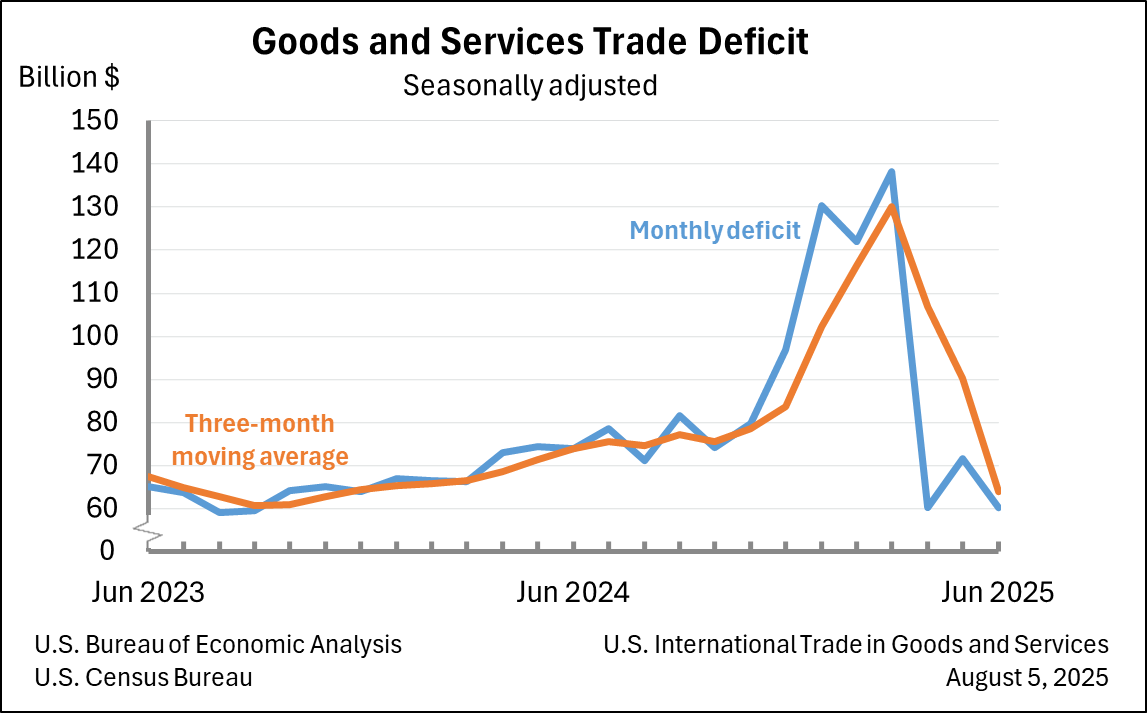Bureau of Economic Analysis
U.S. International Trade in Goods and Services, June 2025
The U.S. goods and services trade deficit decreased in June 2025 according to the U.S. Bureau of Economic Analysis and the U.S. Census Bureau. The deficit decreased from $71.7 billion in May (revised) to $60.2 billion in June, as exports decreased less than imports. The goods deficit decreased $11.4 billion in June to $85.9 billion. The services surplus increased $0.1 billion in June to $25.7 billion.
Principal Federal Economic Indicators
Noteworthy
- 2025 News Release Schedule
- Innovation at BEA
- 2025 Annual Updates
- New! Services Trade Data for More Countries
- Data Tool: Trade in Value Added
- Distribution of State Personal Income
- Updated: RIMS II Regional Multipliers
- Arts and Culture
- Space Economy
- FDI Now in State BEARFACTS
- Quick Guide: Price Indexes
The Latest
Real Consumer Spending Rises in March
Personal income increased 0.5 percent in March after increasing 0.4 percent in February. Wages and salaries, the largest component of personal income, increased 0.6 percent after increasing 0.3 percent.
Current-dollar disposable personal income (DPI), after-tax income, increased 0.5 percent in March after increasing 0.4 percent in February.
Real DPI, income adjusted for taxes and inflation, increased 0.3 percent in March…
Personal Income and Outlays, March 2014
Personal income increased $78.4 billion, or 0.5 percent, and disposable personal income (DPI) increased $68.0 billion, or 0.5 percent, in March, according to the Bureau of Economic Analysis. Personal consumption expenditures (PCE) increased $107.2 billion, or 0.9 percent. In February, personal income increased $54.3 billion, or 0.4 percent, DPI increased $47.6 billion, or 0.4 percent, and PCE increased $54.7 billion, or 0.5 percent, based on…
GDP Growth Slows in First Quarter
Real gross domestic product (GDP) increased 0.1 percent in the first quarter of 2014, according to the “advance” estimate released today by the Bureau of Economic Analysis. In the fourth quarter of 2013, the growth rate was 2.6 percent.
First-quarter GDP highlights The slowdown in real GDP growth reflected:
Gross Domestic Product, 1st quarter 2014 (advance estimate)
Real gross domestic product -- the output of goods and services produced by labor and property located in the United States -- increased at an annual rate of 0.1 percent in the first quarter (that is, from the fourth quarter of 2013 to the first quarter of 2014), according to the "advance" estimate released by the Bureau of Economic Analysis.
New Quarterly Statistics Detail Industries' Economic Performance
The Bureau of Economic Analysis released today – for the first time – gross domestic product (GDP) by industry for 22 industry sectors on a quarterly basis. These new statistics fill an important gap in U.S. federal economic statistics by providing timely information on how individual industries contributed to U.S. economic growth in a given quarter.
New Commerce Data Supports Better Economic Decision-Making by Businesses and Policymakers
This week, the Commerce Department’s Bureau of Economic Analysis (BEA) released two new data products that will help American businesses, consumers, policymakers and academia gain important information about the performance of the U.S. economy.
New BEA Data Proves Valuable for Retail Industry
Guest blog post by Jack Kleinhenz, Ph.D., Chief Economist, National Retail Federation
NRF is the world’s largest retail trade association, representing discount and department stores, home goods and specialty stores, Main Street merchants, grocers, wholesalers, chain restaurants and Internet retailers from the United States and more than 45 countries.
Gross Domestic Product by Industry, 4th quarter and annual 2013
The Bureau of Economic Analysis released today – for the first time – gross domestic product (GDP) by industry for 22 industry sectors on a quarterly basis. These new statistics fill an important gap in U.S. federal economic statistics by providing timely information on how individual industries contributed to U.S. economic growth in a given quarter. These new data also provide businesses with a comprehensive and consistent tool for…
BEA Introduces New Measures of the Regional Economy—Estimates of Real Personal Income for States, 2008–2012
Today, the U.S. Bureau of Economic Analysis released real, price-adjusted estimates of personal income for states and metropolitan areas for 2008-2012. The price-adjustments are based on regional price parities (RPPs) and on BEA’s national Personal Consumption Expenditure (PCE) price index. The RPPs measure geographic differences in the price levels of consumption goods and services relative to the national average, and the PCE…
BEA Introduces New Measures of the Regional Economy—Estimates of Real Personal Income for Metropolitan Areas, 2008–2012
Today, the U.S. Bureau of Economic Analysis released real, price-adjusted estimates of personal income for states and metropolitan areas for 2008-2012. The price-adjustments are based on regional price parities (RPPs) and on BEA’s national Personal Consumption Expenditure (PCE) price index. The RPPs measure geographic differences in the price levels of consumption goods and services relative to the national average, and the PCE…




